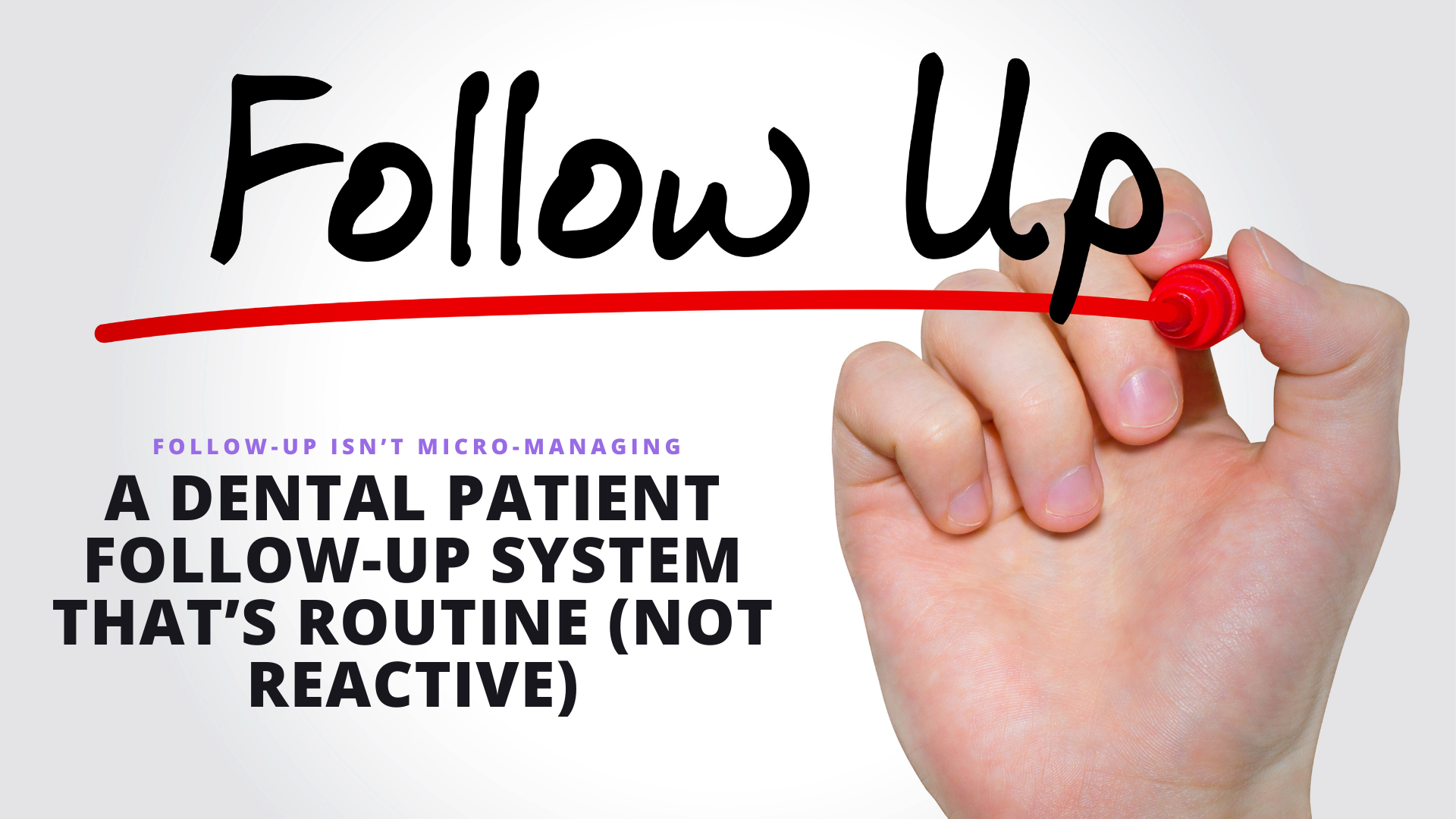Out-of-sight-out-of-mind describes many of life’s forgotten experiences.
You’d like to believe that won’t happen with your dental patients.
Truth is, it does and that makes it all the more vital to have a dental patient follow-up system in place.
Follow-up isn’t micro-managing – it’s a good dental practice management
Think of follow-up as more than a courtesy. Sure, there’s a courteous element to it. But it has a long-term strategic value for your dental patient relationships.
- Follow-up highlights the value of treatment
- Follow-up lifts the value of oral health
- Follow-up creates urgency
As you wrap your thinking around the value of following up with your dental patients you might realize you’re more haphazard and less strategic.
Often a follow-up campaign is launched in response to open schedule blocks or downward trending patient volume. However you’re prompted to deploy a follow-up process it’s best to have an ongoing, routine system in place.
And one that covers the key areas.
- Recall, recare, and reactivations
- Exams and cleanings
- Overdue or unscheduled treatment
These areas have a depth of opportunity. That makes it a good idea to create a specific workflow within your practice management routines.
A dental patient follow-up system that’s routine instead of reactive
Again, the common reason for follow-up drift is not baking it into your daily and weekly workflows. Sure there are time-consuming aspects of it (such as reporting). But the potential outcomes are worth the energy your team invests.
Follow the data “trail”
A dental dashboard is equipped to keep you in the loop about treatment plans, pre-appointment follow-up details, and agreed-upon dates (per patient) when confirmation is acceptable.
Much of your follow-up data can be automated as well. The ability to automate it will add a more timely dimension to it.
- Confirm your dental practice management platform’s capability to sync with your dashboard around follow-up tasks.
- Automate data reviews, reviewing patient appointment histories, and any other follow-up-related information.
- Use data filters to create patient follow-up task lists – including a daily huddle sheet that highlights patients to contact that day.
Include your patients in the follow-up process
Some patients will agree to treatment on the spot. Others want to delay scheduling.
Those who delay become part of your follow-up process. It’s essential that your team has hands-on access to direct an unscheduled patient into your follow-up system.
- Create an “if-not-now-when-can-we-follow up” narrative for patients who prefer to delay scheduling.
- Get agreement from the patient when you can specifically contact them about their unscheduled treatment.
- Provide a timeframe option (e.g. one week from today, etc).
- Use your dental dashboard within your PM platform to create a date-sensitive reminder for follow-up on each patient.
Patient participation will help prevent the “cold-call effect” when you’re prompted to follow up. You can remind them that they asked you to contact them (on the day you reach out) about scheduling their treatment or appointment.
Give your patients a compelling reason to schedule their next appointment or treatment
Again, your narrative is an important leverage point. It pays to research a patient’s dental appointment history.
You can spot trends, review notes related to their care goals, and understand their scheduling preferences (e.g. day, time, etc).
Craft your “talking points” around your patient record discoveries. Merely reminding a patient that “Dr. recommended “X” treatment…” carries less weight than tapping into their personal goals, treatment timing, and showing that you understand their preferences.
If your team uses exam observations make sure they connect the wording to benefits. Pain avoidance, aesthetic improvements, systemic health solutions, etc. have greater emotional and personal impact.
On a related note, your follow-up will lose its energy beyond the third contact. If they haven’t scheduled by then it might be best to consider them uninterested.
Create a written communication at this point. Direct them to call when they’re ready to schedule.
Ultimately, scheduling is their call. Your follow-up strategies help keep their oral health front of mind.
Your follow-up advantage
Any follow-up is better than no follow-up. But it’s to your advantage to have a system in place (preferably an automated one) that keeps your strategy in a routine loop.
The key is gathering available data, analyzing it, and creating actionable strategies around your discoveries. That requires a platform built for data analytics.
Check out the following resources to gain insight into how you can effectively perform data analysis on a dedicated platform:
“Mine” Your Data for Unscheduled Dental Treatment and Increase Your Revenue
The Importance of Dental Dashboards and Dental Analytics
Create a follow-up routine with an all-in-one dental dashboard
The Jarvis Analytics platform helps assure that you’re tracking the important metrics and staying on track with your goals as your dental practice and/or DSO grows and expands.
Jarvis…
- Integrates seamlessly with your chosen practice management software/platform
- Presents the metrics you want and need in an easy-to-view dental dashboard that reduces data complexity for growing dental practices, dental groups, and DSOs
Experience Jarvis in action. Request a demo today!
Or…
Contact us for more information about data tracking that leads to profitability.
LIKE WHAT YOU SEE & READ?
Join thousands of other people, subscribe to our newsletter, and get valuable business tips delivered right to your inbox.


